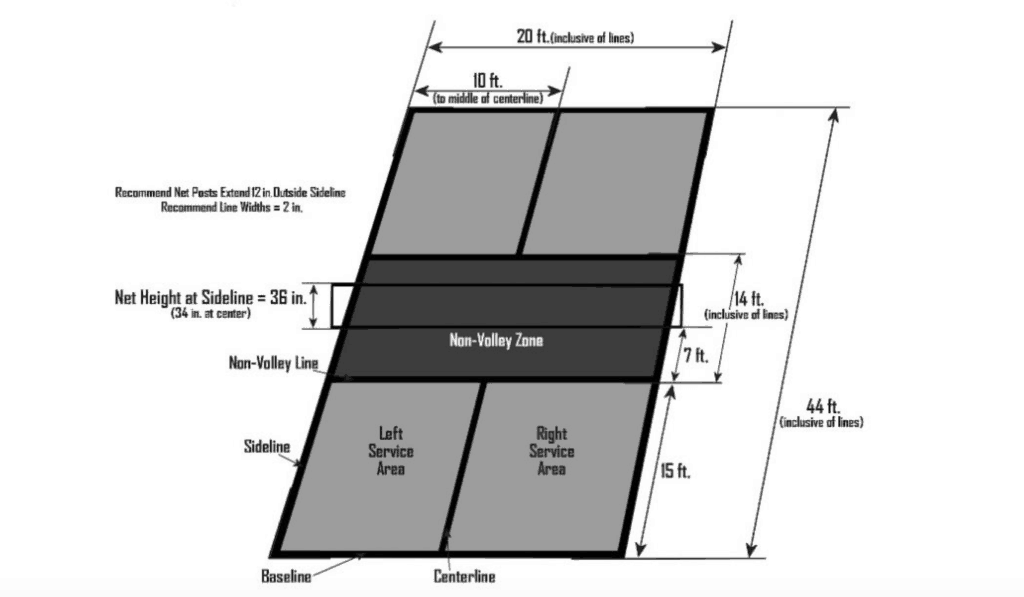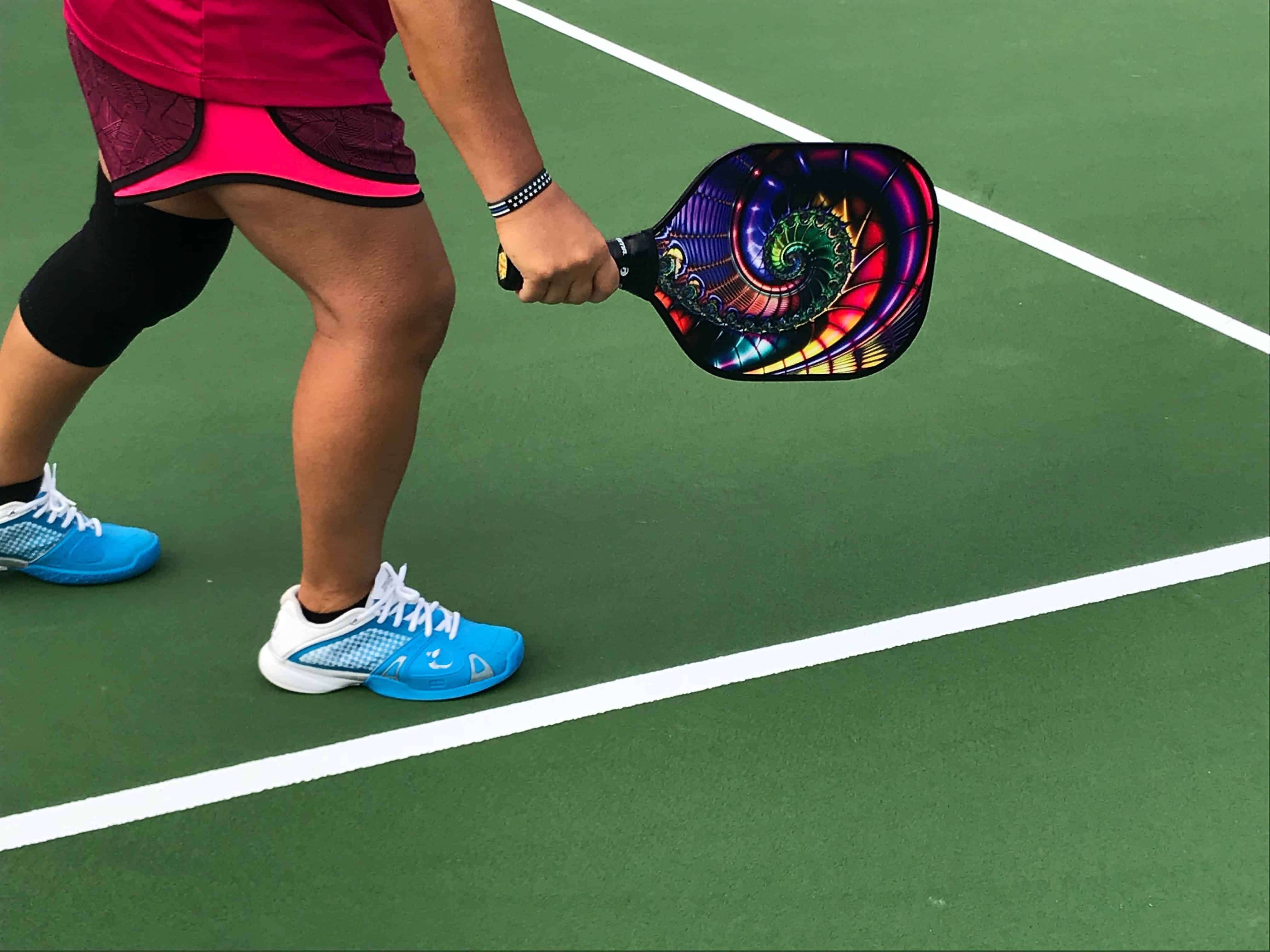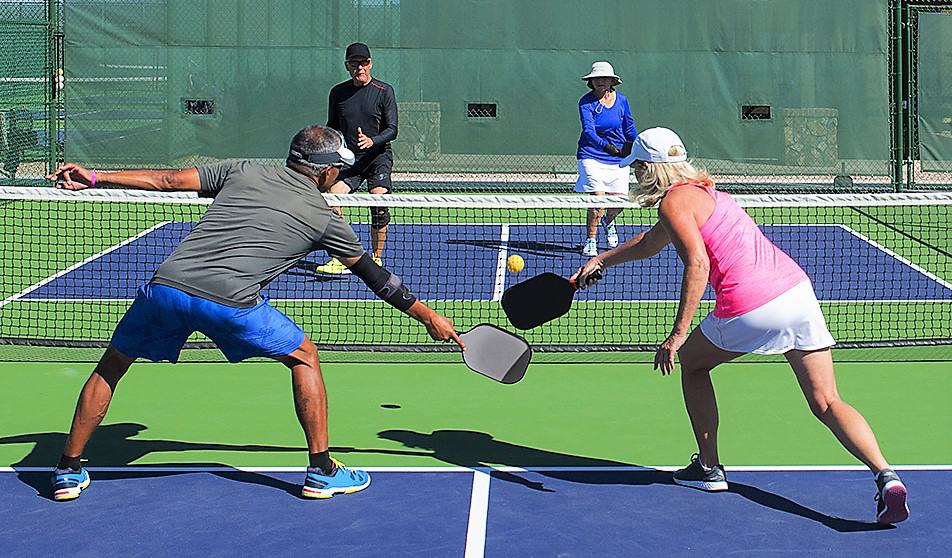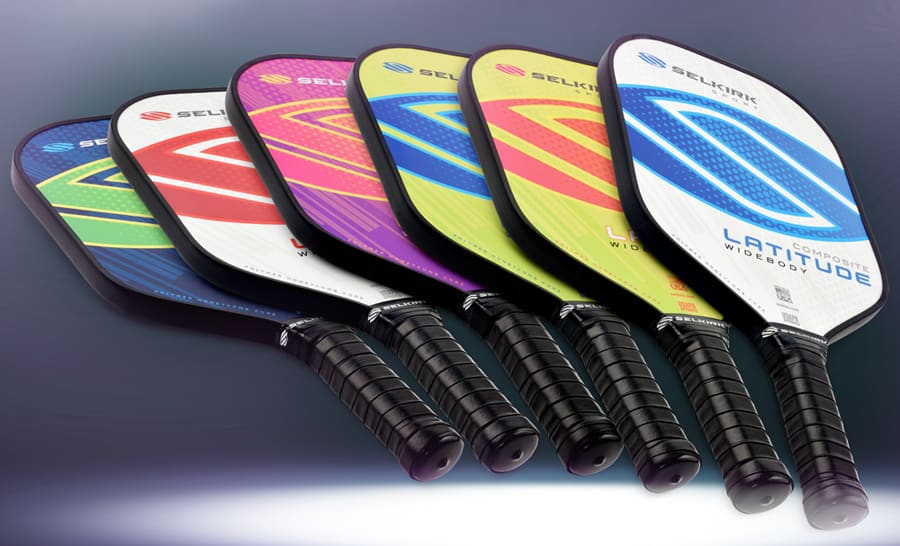Here at PickyPickleball.com, we live and breathe all things pickleball, and that includes first and foremost, playing pickleball every single day. There is nothing more satisfying than playing competitive pickleball or a recreational game with friends on a warm Summer’s day. And that’s why we want to bring as many new players into the sport so that thousands more people across the world can enjoy the amazing benefits pickleball brings.
With that said, if you are new to the game then understanding pickleball rules and the dimensions of a pickleball court are essential introductory steps that you need to master before you can get started – and for some, that can be a daunting task to overcome. That’s why we have created our simple step-by-step guide to pickleball rules and pickleball court dimensions. Throughout this extensive pickleball rules guide, we run through every single piece of information you need to know to master the game of pickleball.
What’s more, every pickleball rule outlines in our pickleball rules step-by-step guide complies with USAPA and IFP guidelines – that means you can be sure to know what you’re talking about when you take on the advice laid out in our pickleball rules guide. So let’s get started!
What is Pickleball?
Starting with the basics, pickleball is a paddle sport that is played with a specially perforated ball (named a pickleball) on a 20-by-44 foot court, divided into two with a tennis-style pickleball net. The court itself is made up of right/even and left/odd service courts and non-volley zones. When serving the ball, players serve underhand diagonally with an underhand motion and player’s then battle it out by playing the ball back and forth across the pickleball net until the point is won.
Pickleball points can only be scored by the serving player or doubles partnership, and points are won when the serving side wins the rally or a fault is committed by the opposing side. In most games, players play until the first side score 11-points and are leading by a minimum 2-point margin. As alluded to above, pickleball is a single or doubles sport and so can be played individually or with a doubles partner.
Before we go any further, it’s also important to note that there are some unique features when it comes to pickleball. Most importantly, there is a two-bounce rule which means that both sides must play at least one groundstroke before players can play a volley shot. On top of this, there is a 7-foot No-Volley Zone which separates the serving box from the net. When standing in the No-Volley Zone (NVZ) players cannot volley the pickleball.
Pickleball Rules Overview
Now that we have covered the essential rules to pickleball, let’s get into the nitty-gritty. Here we run through all of the detailed rules connected to the sport of pickleball. That includes pickleball rules when serving, volleying and calling faults. If you are specifically looking to find pickleball court dimensions, then head down to our pickleball court dimensions guide at the bottom of our step-by-step pickleball rules guide. Here you can check out everything you need to know about constructing your own pickleball court.
Step 1: Learn The Game
When it comes to understanding pickleball rules, nothing beats getting out on the court with more experienced players and getting stuck in. As outlined above, pickleball is a paddle sport that once you grasp, provides hours of endless entertainment. Like other racquet sports such as squash, players can only win points during their own service games. And, when serving, players must serve underhand diagonally from one service box to the opposing service box. Providing you can grasp these simple rules, and you get to grips with the fact that there is a two-bounce rule prior to volleys, as well as a no-volley zone, you will be 90% of the way there.
Once you have got to grips with our step-by-step pickleball rules guide, make sure you get yourself out on the court. Practice serving across the court, respecting the two-bounce rule, and resisting the instinct to smash the pickleball back over the net from within the no-volley zone. Sound fun? Trust us, it is.
Step: 2: Court Dimensions & Pickleball Equipment
When it comes to court dimensions, check out our detailed guide at the bottom of our review. However, if you’re keen to get stuck in now take a look at this pickleball court dimensions breakdown:
Pickleball Court Dimensions
- The overall court measures 20 feet (6.10m) wide x 44 feet (13.41m) long for singles and doubles matches
- Court dimensions should be measured to the outside of the overall perimeter and no-volley zones. All lines should be 2” thick (5.08cm) and should be painted in the same color. The color of the lines should clearly contrast with the overall playing area
- The minimum suggested playing area should be 30 feet (9.14m) wide x 60 feet (18.29m) long, however, it is preferred that courts sit within a 40m x 64m overall zone
Pickleball Court Lines and Areas
- The non-volley zone measures 14 feet long in total, separated by the net in the middle of the court. This subsequently creates two 7 foot non-volley zones on either side of the court
- The remaining area of the court (15 foot) is separated into two boxes on either side of the court which makes up the service zones. The service zones are separated by the centreline which runs from the back of the no-volley zone through to the end of the court
Pickleball Net Dimensions
- Like other racquet sports, the pickleball net should be made from any mesh fabric that does not allow the ball to pass through it
- The posts at either end of the net should be separated by a gap from the inside of each post measuring 22 foot (6.71m), and the maximum post diameter should not surpass 3 inches
- The top of the pickleball net should be edged with 2” (5.08cm) binding tape that runs over the top of the net cable or cord
- The middle of the net should include a center strap that creates a height of 34” (86.36cm) at the middle of the net – all USAPA and IFP compliant pickleball nets will contain a center strap
- The bottom of the net can touch the court surface but should in no way impact or alter gameplay by obstructing the pickleball
Pickleball Specifications
- Pickleballs must range in size between 2.87” and 2.97” in diameter
- Pickleballs must weigh between 0.78 ounces and 0.935 ounces
- They must have a bounce of between 30 and 34 inches when dropped from a height of 78”. If you are testing pickleball specifications then make sure to drop your pickleball onto a granite surface that measures a minimum of 12×12 inches with a minimum depth of 4”. Tests should be carried out at an ambient temperature of 70 degrees
- Pickleballs must have a minimum of 20 perforated holes in the surface of the ball, ranging up to a maximum of 40 perforated holes
- If you are playing in a tournament then the Tournament Director is usually responsible for determining ball selection
Pickleball Clothing & Apparel Rules
When it comes to picking pickleball clothing and apparel for official play, there are a couple of things you need to consider.
- It should not distract other players
- Clothing should include only images with good taste
- Pickleball Shoes must have soles that do not damage or mark court surfaces
- Other than that, you’re good to wear any pickleball clothes that you wish
Step 3: Serve, Service Sequence & Scoring Rules
Now that we have covered off rules connected to setting up your pickleball court, let’s get into the details around serving.
First off, the service motion begins when the serving player swings their hand backward or directly forwards to contact the pickleball. When you start your serving motion, it’s important to remember that both feet need to be behind the service line (baseline) at the back of the court. At the time in which you make contact with the ball during your serve, neither foot is allowed to be on the floor within the serving area, and one foot needs to remain in contact with the floor behind the baseline.
When playing your serve you must make contact with the pickleball when moving your arm in an upward arc, and the ball cannot touch the floor before you make contact. Similarly, you cannot make contact with the pickleball above your waistline, it’s important that you strike your serve when the ball is below your waistline to ensure the service is legal.
Once you’ve played your serve, the ball must land in the service area diagonally opposite on the other side of the net. The serve can land legally on any of the service court lines but cannot land in the no-volley zone. If you hit the net, or the ball bounces off the net and hits your opponent then it is a point for your opposing team.
Where To Stand
The position to serve and receive from is dictated by the score of the game (much like tennis). As long as you win the point when serving, you will retain serve and alternate between the right and left-hand side of the court when serving the ball. Once you lose a point, then your opponent takes over serving until they also lose a point.
When you play singles, you should serve from the right-hand side of the court whenever your score is even (e.g. 0, 2, 4, etc). When you are serving and your points are odd (e.g. 1, 3, 5, etc) then you should serve from the left-hand side of the court.
When playing doubles, both players on the team will serve before losing control of the serve itself, unless it is the start of the game, in which only the starting server serves the ball. The starting server in a new game is therefore designated as the second server for the remainder of the game.
Similarly to the singles game, the starting server serves on the right-hand side when playing even scores and the left-hand side when playing odd. If you are returning serve in a doubles match then you do not alternate positions (similar to tennis).
Step 4: Service & End Selection Rules
Choosing ends is an easy task. Simply use a fair way to decide who gets to select the end (for example a toss of a coin). If you win the coin-toss (or equivalent method) then you can either opt to serve or select your end. As the losing opponent in the coin-toss, you can select whatever the winner neglects. For example, if the winner selects an end, then you can choose to serve or receive first and visa-versa.
When it comes to changing ends, like tennis you change ends every time a service game comes to an end. For those who like to keep time, there is a maximum 2-minute window allowed between each service game.
There are some extra intricacies you need to be aware of though. In a match of two or three games, players change ends midway between each game when the first team or individual scores half the available points in the game. For example, if the game is being played to 11 points, the players change ends when the first player scores 6 points within the game. In a game of 15 points, this changes to 8, and at 21 points this changes to 11.
Step 5: Line Call Rules
There are a whole host of rules and codes of ethics for line calls. We recommend that you learn from your local club or pickleball center the intricacies connected to the place you play, however at the most basic level, the following rules apply.
- If you serve and the ball lands in the relevant service court touching any line, then the ball is called in
- If the ball lands outside of the service court and does not touch a line, then the ball is called out
Step 6: Fault Rules
When it comes to calling faults, most of the calls are logical and follow a similar fashion to tennis. However, it’s good to have them to hand so that you know exactly why I fault might be called, here is a thorough breakdown:
Faults occur when:
- If the service ball does not bounce before the ball is struck – you must allow the ball to bounce when returning serve
- Hitting the ball into the net, and it fails to reach the other side of the court
- Hitting the ball and it lands out of bounds on the other side of the net
- Failure to hit the ball before it bounces twice on your side of the net
- If your clothing or anything that you’re wearing interrupts the ball in any way
- Violation of non-volley zone rules, such as volleying the pickleball within the no-volley zone
- Hitting the ball before it passes over the plain of the net
There are a few more instances that faults will be called. For example, you cannot catch, throw or kick the pickleball. But we thought that it would be a bit exhaustive to go through the more obvious faults that might occur when following the rules of pickleball.
Step 7: Dead Ball Rules
Dead ball pickleball rules cover instances where the ball goes dead through no fault of the players on-court. For example, the ball hitting an object that causes the ball to stop or change direction, the referee calling an incorrect decision, or service let. In the event of a dead ball, pickleball rules state that the point will be restarted and replayed.
Step 8: Non-Volley Rules
When it comes to no-volley rules, this is probably the most unique part of understanding pickleball rules. The no-volley zone is an area of 7 feet on either side of the net whereby the pickleball cannot be volleyed. When standing in the no-volley zone, players cannot volley the pickleball whatsoever, if any part of the body, clothing or paddle makes contact with the ball before it bounces, you are in violation of the no-volley rule.
What’s more, if you volley the ball by starting your action in the no-volley zone, landing outside of the no-volley zone, you still commit a foul. The only time that you can volley the pickleball is if you place two feet outside of the no-volley zone before playing your volley.
Understanding how to utilize the non-volley zone in pickleball is key to learning pickleball rules. Once you grasp the skill of utilizing the no-volley zone, you will become a much better pickleball player.
Step 9: Time-Out Rules
During pickleball games that run for 11 or 15 points, you are entitled to two time-out periods throughout the game. When you are playing a 21 point game, this is extended to three time-out periods. When you call a time-out, you get a 1-minute break in play to regroup and think through/discuss strategy. If you are playing in an official tournament, you will get a 15 second warning that indicates that the time-out period is coming to an end, and you can only call a time-out during a break in play – once the referee calls score indicating the start of a new service action, you cannot call a time-out.
Again, there are many additional rules connected to time-out periods in the event of a medical time-out, presence of blood and other unique scenarios. If you are playing recreationally then you won’t need to worry about these.
Step 10: Other Rules
There are a host of other pickleball rules that it is worth understanding to make the most of your pickleball game. Let’s check them off one by one so that you have a thorough and complete understanding:
- Double Hits: unlike tennis, double-hits are allowed as long as the hit occurs during one smooth action, and is not an intentional action
- Switching Hands: pickleball paddles can be switched between hands as and when required
- Two-Handed Shots: two-handed shots are allowed
- Missed Shots: as long as you do not contact the pickleball, the ball remains in-play
- Broken/Cracked Pickleball: play continues until the end of the rally – if the ball splits or cracks then you can query it with the referee or opposing player and the point can be replayed
- Injury During Play: rally continues until the conclusion of the point, the point is not replayed
- Equipment Problems: rally continues until the conclusion of the point, the point is not replayed
- Items on Court: if you lose an item of clothing or the paddle, the ball remains in play even if the ball makes contact with the item unless it lands in the no-volley zone and makes contact with the ball, in which case it causes a fault
- Distractions: players cannot distract the opponent player when they are about to strike the ball. If they do, it is down to the judgment of the referee to call whether the distraction was legal or not
- Net Posts: If you hit the net post or any associated part of the net post standing out of bounds, and the ball drops dead, a fault is called
- Shots Around Net Post: players may return the ball around the side of the net post, this is a legal action
Court Dimensions Overview
To mark out a pickleball court, there are a couple of key measurements that you need to remember. Firstly, the length and width of the court, as well as the size of the non-volley zone, service boxes, and net. If you are looking to get started right away, following this simple guide to pickleball court dimensions.
- Court Length: 44 feet (13.41m)
- Court Width: 20 feet (6.10m)
- No-Volley Zone: 7 feet (2.13m)
- Service Zone: 15 feet (4.57m)
- The court should be measured to the outside of the overall perimeter and no-volley zones, and all lines should be 2” thick. Lines should be marked in contrasting colors to the court surface
- The centreline should run from the back of the no-volley zone, starting at the midpoint, through to the back of the court, creating two service boxes on either side of the court

Court Layout
To ensure that you mark out the correct dimension of a pickleball court, follow this simple step-by-step guide to measuring and marketing pickleball court dimensions.
- Start by marking out the net, which should be 20 feet between the sidelines, covering the total width of the court. It is advised that outdoor courts in the United States are positioned facing 15-25 degrees west of true north to avoid the impact of weather and sun direction on play
- Locate the center of the net and measure 10 feet to either side of the net. This midpoint marks the center of the court. Once you have done so, measure 42 feet at right angles to the edge of the net to get the baseline corner points at the back of the court. To check that you are straight, measure diagonally corner-to-corner to ensure that there is a measurement of 29 feet-8-¾” – this will ensure that you have a perfect outer perimeter on each side of the court
- To double-check your measurements, make sure that the distance across the net and baseline both measure 20 feet exactly
- Now measure 7 feet back from both sides of the net, and mark across the width of the court to establish the no-volley zone
- From there, you can mark the center point on both the no-volley zone line and baseline, which needs to be joined to create the service boxes
- All lines should be 2” wide and marked in a color that contrasts with the surface color of the court
- By following these simple steps, you can mark out the dimensions of a pickleball court anywhere.
Pickleball Rules Summary
We hope that you have found our simple step-by-step-guide to pickleball rules and the dimensions of a pickleball court useful. Here at PickyPickleball.com, we welcome your input into making our comprehensive pickleball rules guide even better. So if you have advice on how we can make things clearer – please do get in touch!
As we said when we started our pickleball rules guide, the sport of pickleball is a brilliant game to enjoy with friends or to play competitively. There is a reason it has been named America’s fastest-growing sport, and we cannot wait to enjoy the wild ride that awaits us as the sport of pickleball continues to grow. For now, Happy Pickleball People!






